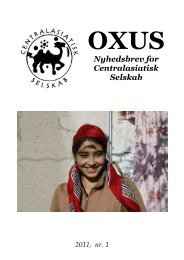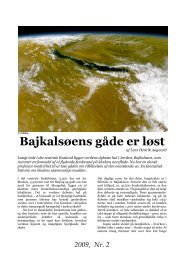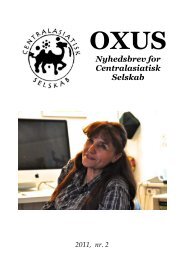Mette Hedemand Søltoft - Centralasiatisk Selskab
Mette Hedemand Søltoft - Centralasiatisk Selskab
Mette Hedemand Søltoft - Centralasiatisk Selskab
Create successful ePaper yourself
Turn your PDF publications into a flip-book with our unique Google optimized e-Paper software.
English summary<br />
The debate on Orientalism has mostly been focused on the relationship between the Arabs and the<br />
West. The conflicts and problems in these discussions are, however, difficult to apply to another<br />
oriental field, namely Iranian Studies, which are the subject of this dissertation. Compared to Semitic<br />
Studies Iranian Studies have their own scientific tradition, particularly due to the discovery of the Indo-<br />
European family of languages in the beginning of the 19 th century, when the Iranian and Indian<br />
languages “suddenly” became closely related to the European languages.<br />
I have examined the early development of Iranian Studies in Denmark through the example of<br />
Professor Arthur Christensen’s (1875-1945) three journeys to Iran in 1914, 1929 and 1934. Professor<br />
Christensen was the first professor of Iranian Studies at The University of Copenhagen, Denmark, and<br />
his scientific research has until this day made him an internationally recognized authority in this field.<br />
When Arthur Christensen visited Iran in 1929 he found himself to be a famous man among the national<br />
romantic intellectuals. The national romantics regarded his work on the pre-Islamic period as the<br />
“proof” of their golden past. The Iranian national romantics with Reza Shah Pahlavi as their leader<br />
wanted to establish an Iranian nation without Islam. They viewed Islam as an uncivilized and Semitic<br />
religion, which was foreign to their Indo-Iranian culture.<br />
Arthur Christensen on his side was happy to make himself useful in this nation-building movement. In<br />
fact he became so enthusiastic about what he experienced that he adopted several political and<br />
ideological thoughts from the Iranian national romantics. Arthur Christensen was no exception;<br />
generally Iranian Studies in the west were politically and ideologically very close to the Pahlavi<br />
regime. This close relationship between academia and Iranian national romantics continued during the<br />
reign of Muhammad Reza Shah, lasting until the late 1970s. Consequently the Islamic revolution in<br />
1979 was a schock to Iranian Studies, and Iranian Studies are still trying to deal with the repercussions<br />
from this occurrence.<br />
For that reason among others the history of Iranian Studies differs from other Oriental Studies.<br />
130<br />
DSCA Monografi/Monograph 1 ▪ 2007









